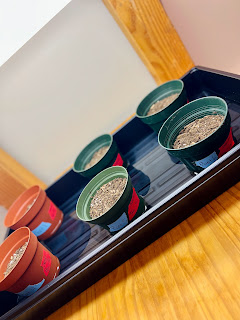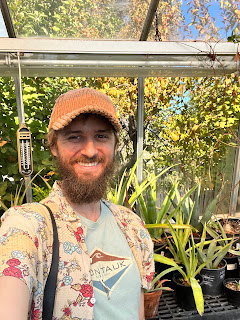Day twenty-two
Alex Shaw
Josh James
Thursday, September 22nd
Detecting plant communication using proposed methods
Abstract:
Plants and bacterium are responsible for oxygenating the planet; therefore, we owe our existence in large part to their resilience and mere presence. Observation, learning, and coexisting with plants are essential to broaden our understanding of our species. The how and why of our existence are symbiotically intertwined with theirs; their significance is immeasurable. Research surrounding plants has evolved throughout the centuries, beginning with the most basic handwritten observations and studies, all the way up to detailed genetic research and insight. Hassanien of the College of Water Resources and Civil Engineering in China was able to conclude that "Sound waves at 1 kHz and 100 dB for 1 h within a distance of 0.20 m could significantly promote the division and cell wall fluidity of callus cells and also significantly enhance the activity of protective enzymes and endogenous hormones." (Hassanien)
According to these findings, sound waves positively interacted with the plants and helped set a baseline for what is possible. If Hassanien's findings are correct, what else can sound do? What else could audio-rooted information tell us about plants? To stop and wonder about plants is to wonder about ourselves. Knowing how reactive plants are to sound waves, one might wonder, are plants interested in other plants? Do plants have the ability and will to communicate with one another? Alternatively, could it be minimal sensory information sent back and forth? Khait working in The Plant Sciences department at Tel Aviv University, shows that it is possible. "We recorded ∼65 dBSPL ultrasonic sounds 10 cm from tomato and tobacco plants, implying that these sounds could be detected by some organisms from up to several meters away." (Khait abstract) This finding struck me as I sat surrounded by my specimens. Dozens of different kinds, all were living together and interacting. I observed that the communities that not only lived but thrived were the larger ones (plants totaling three or more). Quite often, if I had placed a plant off to the side alone, it had a statistically higher chance of weeping or perishing. If one could measure this from meters away, maybe an isolated chamber would wield even better results.
Overview:
Expected results may include detecting plants' ability to communicate with one another using echolocation and an EKG. For this to be measurable, the environment must be isolated in a quiet area. The selected plants' Solanum lycopersicum, or yellow pear tomato, are to be grown from seed in a monitored grow chamber, leading to optimized results. Khait experienced favorable results from their experiment before there was any viable information viable on the topic. "Three control groups were used – empty pots, and two groups of untreated plants: self-control – the same plant before treatment, and neighbor-control –untreated plants that shared the acoustic box with treated plants. All treatment groups emitted significantly more sound than all control groups…” (Khait 115)
Setting a baseline with the soil level, water intake, and grow light to command concordant data. The plants will be subject to different stress levels upon adulthood by cutting and removing leaves. Once the plant rises to the proper stress level, electrical, chemical, or auditory information will be expressed, which will be measurable. One would not be looking to detect base plants communicating with removed leaflets but rather with each other. The plants will not be put through as much stress as to perish; minimal scoring and removing should suffice.
Let us say that all this is indeed measurable, as Khait’s results imply. How is it measurable? What exactly are we listening to? What exchange is taking place inside the plant that produces auditory information? Zweifel of the Swiss Federal Institute is confident in a process called cavitation. “Ultrasonic acoustic emission (UAE) in trees is often related to collapsing water columns in the flow path as a result of tensions that are too strong (cavitation).” (Zweifel 1080)
Research Question: Do plants have the ability to communicate with one another when their stress levels rise; due to negative stimulation like scoring, withholding water/sunlight, and if so, how would we be able to detect this?
Hypothesis: Once the plant rises to the directed stress level, there will be electrical or auditory information expressed, and this information will be measurable with an EKG or an echo-location device.
Possible Results: The possibility that nothing will be measured is always looming. That’s why consistent data and record keeping is at the forefront.
Possible outcome 1: The soundproof chamber doesn’t suffice, and too much noise gets in; muddling our recordings
Possible outcome 2: The experiment has to many variables, and/or we are unable to establish a baseline
Possible outcome 3: The plant’s stress levels rise, but our device is not sensitive enough to detect it.
Possible Outcome 4: The stress levels rise like expected, the soundproof environment works, and the device is sensitive enough.
 (Figure 2) Fig. 4. Effect of
sound frequencies on plant temperature/heat in drought stress environment. Note
Infra-Red thermal images we're taken by FLIR SC-620 camera. Reflected temperature reading was pasted at the top of each. (Mi-Jeong Jeong
2018)
(Figure 2) Fig. 4. Effect of
sound frequencies on plant temperature/heat in drought stress environment. Note
Infra-Red thermal images we're taken by FLIR SC-620 camera. Reflected temperature reading was pasted at the top of each. (Mi-Jeong Jeong
2018)
Notes on Figures:
Figures 1 and 2 encourage our team, not to re-create similar
results, but to continue onward with the achievable. *Figure 2, shows viable
effects of audio stimulation and increased stomatal conductance. It was
observed that drought-tolerant plants exploit the fitness by
lessening leaf
size and stomatal conductance to water vapor in response to water
scarcity (Nativ et al., 1999;Ares et
al., 2000)
(Mi-Jeong Jeong 2018)
Variable Table:
|
Name |
I/D/C |
Symbol |
Units |
Description |
|
Plant being stressed/injured |
I |
σ |
N/A |
Plants being scored, withheld water and light |
|
Stress is measurable/detected |
D |
∴
|
Hz, mV |
The plants communicating with each other auditorily or electrically |
|
Sunlight |
C |
Λ |
cd |
The grow light was consistent |
|
Time |
C |
t |
s |
They all had the same time to grow |
|
Water
|
C |
» |
ℓ |
They we’re all given the same amount of water |
|
Temperature |
C |
K |
F°/C°
|
They we're grown all in the same temperature |
|
Soil |
C |
|
m |
They all received the same grade soil, depth and density. |
Plants” Journal of Integrative Agriculture, vol. 13, no. 2, Feb. 2014, pp. 335
348. Science Direct, https://doi.org/10.1016/S2095-3119(13)60492-X. Accessed Sep.
18th 2022
Jeong, Mi-Jeong, and Jung-II Cho, et al. “Sound frequencies induce drought tolerance in rice
plant” Pakistan Journal of Botony. 46(6): 2015-2020, 2014. ResearchGate
https://www.researchgate.net/publication/274890230_Sound_frequencies_induce_droug
ht_tolerance_in_rice_plant. Accessed Sep. 18th 2022
Khait, I., and O. Lewin-Epstein, et al. “Plants emit informative airborne sounds under stress.”
Prévost V, and David K, et al. “Diffusions of sound frequencies designed to target
dehydrins induce hydric stress tolerance in Pisum sativum seedings” Heliyon, PMID:
32995644; PMCID: PMC7511810. Sep. 2020, National Library of Medicine,
DOI:https://doi.org/10.1016/j.heliyon.2020.e04991. Accessed Sep. 18th 2022
Zweifel, R., and F. Zeugin. “Ultrasonic acoustic emissions in drought-stressed trees – more than
signals from cavitation?” New Phytologist, vol. 179, July 2008, pp. 1070-1090.
ResearchGate, DOI:10.1111/j.1469-8137.2008.02521.x. Accessed Sep. 18th 2022




Comments
Post a Comment